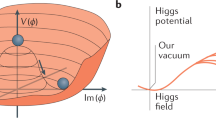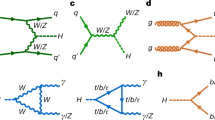Abstract
In supersymmetric (SUSY) theories1, the photino is the fermion partner of the photon and is expected to be the lightest stable particle. Despite many discussions of the possible production of photinos, and other supersymmetric particles, at existing and proposed accelerators2, so far, experiments have only set limits3,4. We propose here that photinos are produced by sources of ultra-high-energy cosmic rays. We specifically consider Cygnus X-3, which is a powerful source of neutral particles up to 104 TeV (refs 5–8). These are usually assumed to be γ rays, but there is no direct evidence for this, and shower5,6 and underground9,10 experiments suggest that there may be another component present. Here we estimate that a photino flux of the order of 10−14 cm−2 s−1 above 10 TeV is possible from a source such as Cyg X-3, under certain conditions, and consider the feasibility of detecting these photinos.
This is a preview of subscription content, access via your institution
Access options
Subscribe to this journal
Receive 51 print issues and online access
$199.00 per year
only $3.90 per issue
Buy this article
- Purchase on Springer Link
- Instant access to full article PDF
Prices may be subject to local taxes which are calculated during checkout
Similar content being viewed by others
References
Nanopoulos, D. V. & Savoy-Navarro, A. (eds), Phys. Rep. 105, 1–140 (1984).
Savoy-Navarro, A. Phys. Rep. 105, 1–140 91–120 (1984).
Yamada, S. Int. Lepton/Photon Symp., 525–564 (F. R. Newman Laboratory of Nuclear Studies, Cornell Univerisity, Ithaca, 1983).
Komamiya, S. Proc. Supersymmetry versus Experiment Workshop, TH. 3311/EP. 82/63-CERN, 57–63 (1982).
Samorski, M. & Stamm, W. Astrophys. J. Lett. 268, L17–21 (1983).
Lloyd-Evans, L. et al. Nature 305, 784–787 (1983).
Stanev, T., Gaisser, T. & Halzen, F. & Gaisser, T. K. Workshops on Cosmic Rays and High Energy Gamma Ray Experiments for the Space Station Era (Baton Rouge, Louisiana, 1984).
Stanev, T. & Ch. P. Vankov, Proc. 19th int. Cosmic Ray Conf., La Jolla, 7, 219–222 (NASA, 1985).
Marshak, M. L. et al. Phys. Rev. Lett. 54, 2079 (1985).
Battistoni, G. et al. Phys. Lett. 155 B, 465–467 (1985).
Stenger, V. J. Astrophys. J. 284, 810–826 (1984).
Fayet, P. Phys. Lett. 86B, 272–278 (1979).
Kane, G. L. & Leveille, J. P. Phys. Lett. 112 B, 227–232 (1982).
Harrison, P. R. & Llewellyn-Smith, C. H. Nucl. Phys. B213, 223–240 (1983).
Lee, H. & Bludman, S. A. Astrophys. J. 290, 28–32 (1985).
Stepanian, A. A. Adv. Space Res. 3, 123–130 (1984).
Baltrusatis, R. M. et al. Proc. 19th int. Cosmic Theory Conf., La Jolla, 8, 1104–1041 (NASA, 1985).
Eichler, D. & Vestrand, W. Nature 307, 613–614 (1984).
Hillas, A. M. Nature 312, 50–51 (1984).
Chanmugam, G. & Brecher, K. Nature 313, 767–768 (1985).
Stecker, F., Harding, A. & Barnard, J. Nature 316, 418–420 (1985).
Kolb, E., Turner, M. & Walker, T. Phys. Rev. (submitted).
Barnhill, M. V., Gaisser, T. K., Stanev, T. & Halzen, F. Univ. Wisconsin Rep. MAD/PH/243 (in the press).
Kitamura, T. Proc. 17th int. Cosmic Ray Conf., Paris 13, 361–380 (CEN Saclay, 1981).
Arnison, G. et al. Phys. Lett. 147B, 222–226 (1984).
Dowthwaite, J. C. et al. Nature 309, 692–693 (1984).
Cawley, M. F. et al. Proc. 19th int. Cosmic Ray Conf., La Jolla 1, 219–222 (NASA, 1985).
Baltrusaitis, R. M. et al. Proc. 19th int. Cosmic Ray Conf., La Jolla, 1, 111–114 (NASA, 1985).
Protheroe, R. J. & Clay, R. W. Nature 315, 205–207 (1985).
Bergsma, F. et al. Phys. Lett. 121B, 429–432 (1983).
Ball, R. C. et al. Phys. Rev. Lett. 14, 1314–1317 (1984).
Arnison, G. et al. Phys. Lett. 139B, 115–125 (1984).
Ellis, J. & Kowalski, H. Phys. Lett. 142B, 441–445 (1984).
Barger, V., Hagiwara, K., Woodside, J. & Keung, W.-Y. Phys. Rev. Lett. 53, 641–643 (1984).
Reya, E. & Roy, D. Phys. Rev. Lett. 53, 881–884 (1984).
Ellis, J. & Kowalski, H. CERN-TH.4126/85 (1985).
Author information
Authors and Affiliations
Rights and permissions
About this article
Cite this article
Stenger, V. Photinos from cosmic sources. Nature 317, 411–413 (1985). https://doi.org/10.1038/317411a0
Received:
Accepted:
Issue Date:
DOI: https://doi.org/10.1038/317411a0
Comments
By submitting a comment you agree to abide by our Terms and Community Guidelines. If you find something abusive or that does not comply with our terms or guidelines please flag it as inappropriate.



